Paper Menu >>
Journal Menu >>
 Journal of Minerals & Materials Characterization & Engineering, Vol. 9, No.6, pp.527-538, 2010 jmmce.org Printed in the USA. All rights reserved 527 Microstructure and Mechanical Properties of Ceramic Composites 1 V.S. Aigbodion*, 2 J. O. Agunsoye, 1 V. Kalu, 1 F. Asuke, 3 S. Ola 1 Department of Metallurgical and Materials Engineering, Ahmadu Bello University, Zaria, Nigeria 2 Department of Metallurgical and Materials Engineering, University of Lagos, Nigeria 3 National Metallurgical Development Centre, Jos, Nigeria *Corresponding Author: aigbodionv@yahoo.com ABSTRACT Ceramic matrix composites reinforced with metals have been developed to overcome the intensive brittleness and lack of reliability of monolithic ceramics, with a view to introduce ceramics in structural parts used in severe environments such as rocket and jet engines, gas turbines for power plants, heat shields for space vehicles, fusion reactor first wall, aircraft brakes, heat treatment furnaces. In view of these the effects of Al-6%Si alloy particles on the as- cast microstructure and properties of Tin Tailings ceramics matrix composites produced by powder metallurgy method have been studied. 5-30 weight percent Al-6%Si alloy particles were added. The results revealed that, addition of Al-6%Si alloy reinforcement increased the linear shrinkage, strength and impact energy with a decreased in density, porosity and hardness value. These increases in strength and impact energy are attributed to the uniform distribution and strong bonding of the soft metal phase in the hard ceramic matrix. These results show that better properties are achievable by addition of Al-6%Si alloy to Tin Tailings. Keywords: Al-Si alloy, Hardness, Impact energy, Microstructure, Tin tailings and Strength 1. INTRODUCTION Ceramic matrix composites (CMCs) as the name implies combine reinforcing ceramic or metal phases with a ceramic matrix to create materials with new and superior properties [1].  528 V.S. Aigbodion, J.O. Agunsoye, V. Kalu, F. Asuke, S. Ola Vol.9, No.6 CMCs have been developed to overcome the intensive brittleness and lack of reliability of monolithic ceramics, with a view to introduce ceramics in structural parts used in severe environments such as rocket and jet engines, gas turbines for power plants, heat shields for space vehicles, fusion reactor first wall, aircraft brakes, heat treatment furnaces, etc. It is generally admitted that the use of CMCs in advanced engines will allow an increase of the temperature at which the engine can be operated and eventually the elimination of the cooling fluids, both resulting in an increase of yield [2]. The ceramic matrix (CMCs) used at high temperatures include silicon carbide, carbon, alumina, silica, zirconia and other elements. Ceramic matrices can be categorized as either oxides or monoxides and in some cases may contain residual metal after processing [1, 3 and 4]. Tin tailings are waste product obtained from the beneficiation of tin ore in the mining industry. Previous research on this waste product show that the tailings are dark-brown in colour, can withstand temperature above 1800 0 C, chemical analysis indicates that it contains principally Zirconia in the form of ZrO and silica having percentages of 68.7% and 11% respectively and it is very hard and brittle [5]. In order to increase the toughness and strength of Tin tailings for industrial and engineering applications, hence, the present research which intends to add Al-Si alloy to Tin tailings and study its characteristic behaviour through microstructural and properties analysis. 2. MATERIALS AND METHODS 2.1 Materials The Tin tailings used in this work are dark brown, fine powder of particle size(64µm) The particles are not synthetic being obtained from the Tin mining field in Jos, Plateau State Nigeria Al-6%Si alloy used was produced and grinded into powder form using a ball mill and sieve to a particle size of (100µm) at the foundry shop of the Metallurgical and Materials Engineering department, Ahmadu Bello University Zaria, Nigeria. 2.2 Equipment The equipment used in this study include: moulding box, measuring cylinder, hydraulic press, oven, furnace, charpy impact tester, Rockwell hardness, Denison universal strength testing machine and metallurgical microscope. 2.3 Methods 2.3.1 Samples Preparation  Vol.9, No.6 Microstructure and Mechanical Properties of Ceramic Composites 529 Preparation of the test samples involved mixing of the Tin tailings with weight fraction of Al- 6%Si alloy powder from 0 to 30% with interval of 5%; the mixed blend is packed into a metal moulding box and pressed using hydraulic press. A force of 300KN was applied to enhance homogeneity and surface smoothness of the test samples. The mould piece was dried in open air for 3 days, followed by drying in oven for 12 hrs at 110 0 C to expel any moisture left in the piece and to avoid crack during sintering. Sintering was carried out in an electric heating furnace pre set at heating rate of 7 0 C / min and the sintering procedure were as follows[5]: (a) Heating to a temperature 250 0 C and allow to soak for 6 hours. (b) Followed by heating for 4 hours at a temperature 450 0 C (c) Finally heating for 3 hours at 800 0 C After sintering, the linear shrinkage, porosity and density of the samples were determined. The samples were machined into tensile strength; impact and hardness test samples for the purpose of determining the mechanical properties. The microstructures were obtained by the use of metallurgical microscope with a built-in camera [6]. 2.3.2 Linear Shrinkage After moulding of the samples, its green state dimension was measured and recorded as L A , then the fired dimension L B was measured. The linear shrinkage was estimated according to the relation [5]. %LDS d = 100x L LL B BA − Where, LDS d = Linear drying shrinkage L A = the green dimension L B = the dry dimension 2.3.3 Porosity Porosity originates from the voids, which are created within the bulk. These pores are of two kinds; open and closed pores. The open or otherwise known as apparent porosity measures the fraction of void volume to the material volume. The open pores are usually interconnected so that they provide passages through which gases can pass [1]. The following procedure was used in determining the porosity. The samples were kept in the oven at 110 0 C for 3h to obtain constant weight W 1 . The samples was then suspended in distilled water and boiled on a hot plate for 30 minutes. After boiling while still in hot water, the water  530 V.S. Aigbodion, J.O. Agunsoye, V. Kalu, F. Asuke, S. Ola Vol.9, No.6 was displaced with cold water, the weight W 2 was measured on a digital balance hinged on the tripod stand. The test sample was removed from the water and extra water wiped off from the surface by lightly blotting the sample with wet towel and the weight W 3 of the soaked sample suspended in air was measured. The apparent porosity of the sample was determined from the relationship [6]. Pa = %100 23 13 x WW WW − − Where; Pa = apparent porosity W 3 = Weight in air W 1 = Weight of the sample W 2 = Weight in cold water. 2.3.4 Density The density of the respective samples was determined basically by measuring the mass and the volume by using the beam balance and the measuring cylinder respectively. It is then estimated from the formula given below [5-7]. Density (g/cm 3 ) = )( )( 3 cmVolume gMass 2.3.5 Tensile Test The tensile tests were conducted on Denison Universal Strength Testing Machine, using standard tensile test sample [7]. Each sample was threaded using a lathe machine to mark stripes to enable a proper gripping by the machine during testing, as the test was going on, the results were shown on the screen with the yield strength and ultimate tensile strength been calculated as follows[5, 6] Tensile strength = ( ) 2 /mmN Area LoadMaximum Stress at yield = ( ) ./ 2 mmN Area yieldatLoad 2.3.6 Hardness Test The test samples were cleaned with a water proof silicon cloth to provide a lustrous surface and placed on the anvil of the machine. The indenter used was a 1.56mm steel ball and a minor load of 10kg and major load of 100kg was applied. Rockwell B scale and Hardness of 101.2HRB standard block was used [6]. 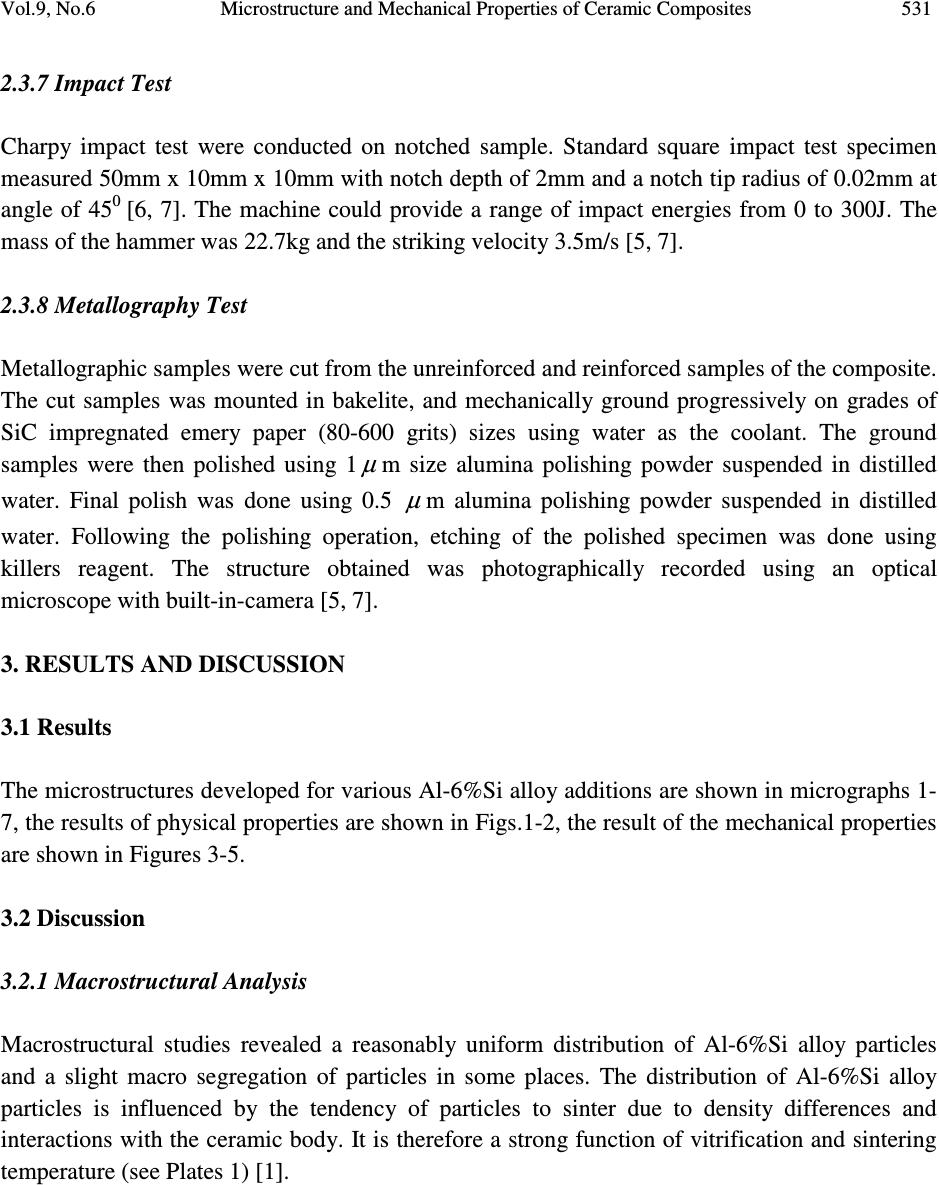 Vol.9, No.6 Microstructure and Mechanical Properties of Ceramic Composites 531 2.3.7 Impact Test Charpy impact test were conducted on notched sample. Standard square impact test specimen measured 50mm x 10mm x 10mm with notch depth of 2mm and a notch tip radius of 0.02mm at angle of 45 0 [6, 7]. The machine could provide a range of impact energies from 0 to 300J. The mass of the hammer was 22.7kg and the striking velocity 3.5m/s [5, 7]. 2.3.8 Metallography Test Metallographic samples were cut from the unreinforced and reinforced samples of the composite. The cut samples was mounted in bakelite, and mechanically ground progressively on grades of SiC impregnated emery paper (80-600 grits) sizes using water as the coolant. The ground samples were then polished using 1 µ m size alumina polishing powder suspended in distilled water. Final polish was done using 0.5 µ m alumina polishing powder suspended in distilled water. Following the polishing operation, etching of the polished specimen was done using killers reagent. The structure obtained was photographically recorded using an optical microscope with built-in-camera [5, 7]. 3. RESULTS AND DISCUSSION 3.1 Results The microstructures developed for various Al-6%Si alloy additions are shown in micrographs 1- 7, the results of physical properties are shown in Figs.1-2, the result of the mechanical properties are shown in Figures 3-5. 3.2 Discussion 3.2.1 Macrostructural Analysis Macrostructural studies revealed a reasonably uniform distribution of Al-6%Si alloy particles and a slight macro segregation of particles in some places. The distribution of Al-6%Si alloy particles is influenced by the tendency of particles to sinter due to density differences and interactions with the ceramic body. It is therefore a strong function of vitrification and sintering temperature (see Plates 1) [1]. 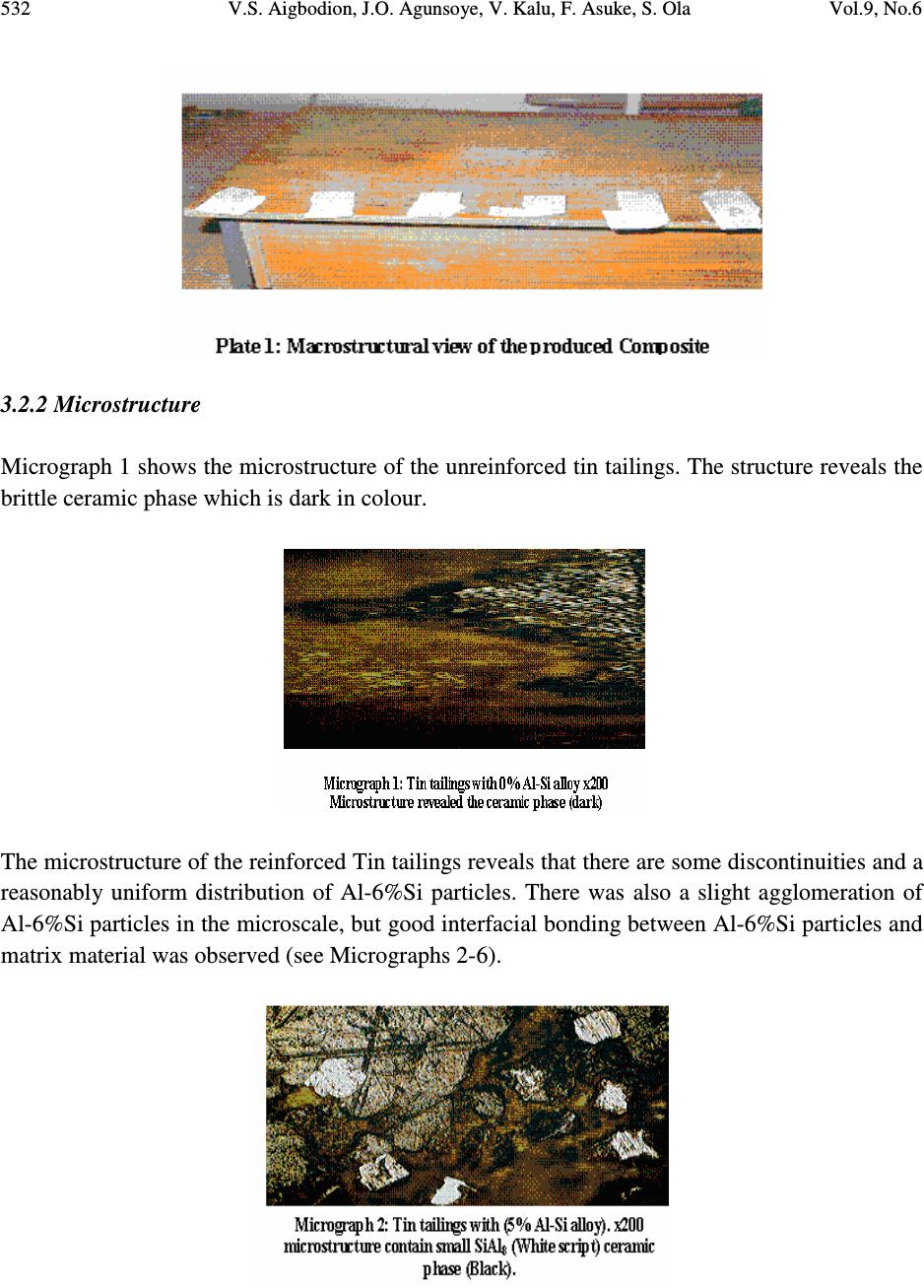 532 V.S. Aigbodion, J.O. Agunsoye, V. Kalu, F. Asuke, S. Ola Vol.9, No.6 3.2.2 Microstructure Micrograph 1 shows the microstructure of the unreinforced tin tailings. The structure reveals the brittle ceramic phase which is dark in colour. The microstructure of the reinforced Tin tailings reveals that there are some discontinuities and a reasonably uniform distribution of Al-6%Si particles. There was also a slight agglomeration of Al-6%Si particles in the microscale, but good interfacial bonding between Al-6%Si particles and matrix material was observed (see Micrographs 2-6). 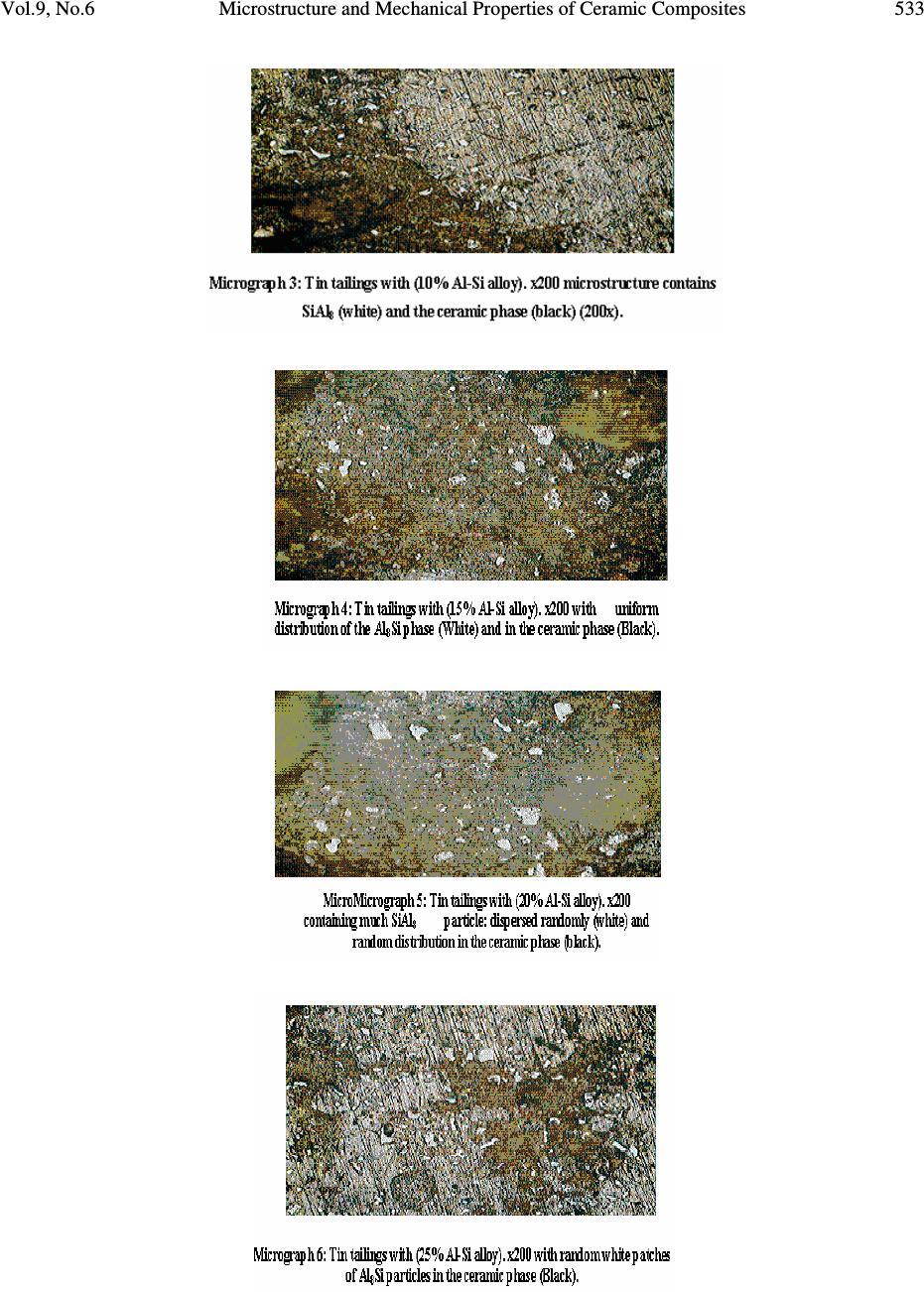 Vol.9, No.6 Microstructure and Mechanical Properties of Ceramic Composites 533 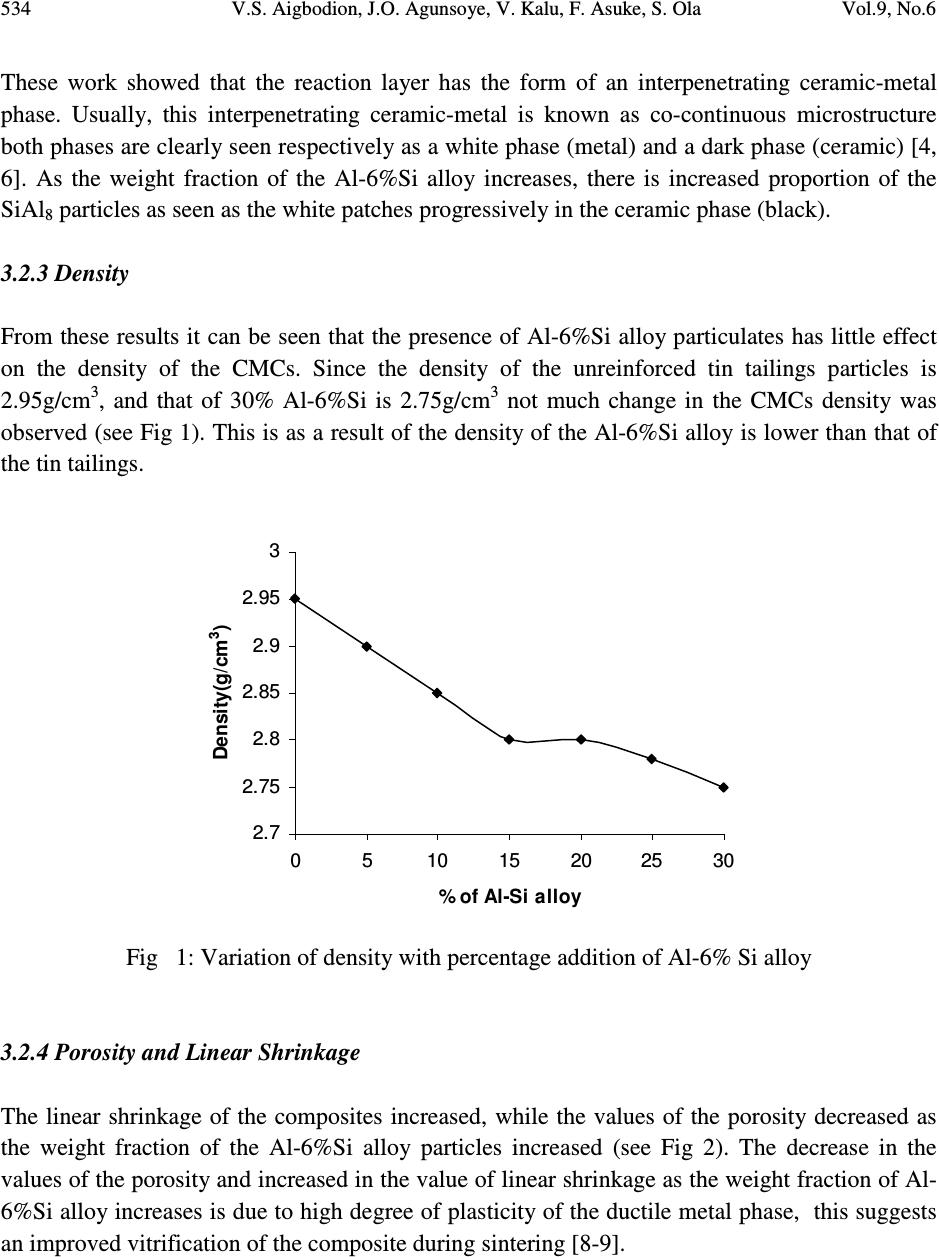 534 V.S. Aigbodion, J.O. Agunsoye, V. Kalu, F. Asuke, S. Ola Vol.9, No.6 These work showed that the reaction layer has the form of an interpenetrating ceramic-metal phase. Usually, this interpenetrating ceramic-metal is known as co-continuous microstructure both phases are clearly seen respectively as a white phase (metal) and a dark phase (ceramic) [4, 6]. As the weight fraction of the Al-6%Si alloy increases, there is increased proportion of the SiAl 8 particles as seen as the white patches progressively in the ceramic phase (black). 3.2.3 Density From these results it can be seen that the presence of Al-6%Si alloy particulates has little effect on the density of the CMCs. Since the density of the unreinforced tin tailings particles is 2.95g/cm 3 , and that of 30% Al-6%Si is 2.75g/cm 3 not much change in the CMCs density was observed (see Fig 1). This is as a result of the density of the Al-6%Si alloy is lower than that of the tin tailings. 2.7 2.75 2.8 2.85 2.9 2.95 3 0510 15 2025 30 % of Al-Si alloy Density(g/cm 3 ) Fig 1: Variation of density with percentage addition of Al-6% Si alloy 3.2.4 Porosity and Linear Shrinkage The linear shrinkage of the composites increased, while the values of the porosity decreased as the weight fraction of the Al-6%Si alloy particles increased (see Fig 2). The decrease in the values of the porosity and increased in the value of linear shrinkage as the weight fraction of Al- 6%Si alloy increases is due to high degree of plasticity of the ductile metal phase, this suggests an improved vitrification of the composite during sintering [8-9]. 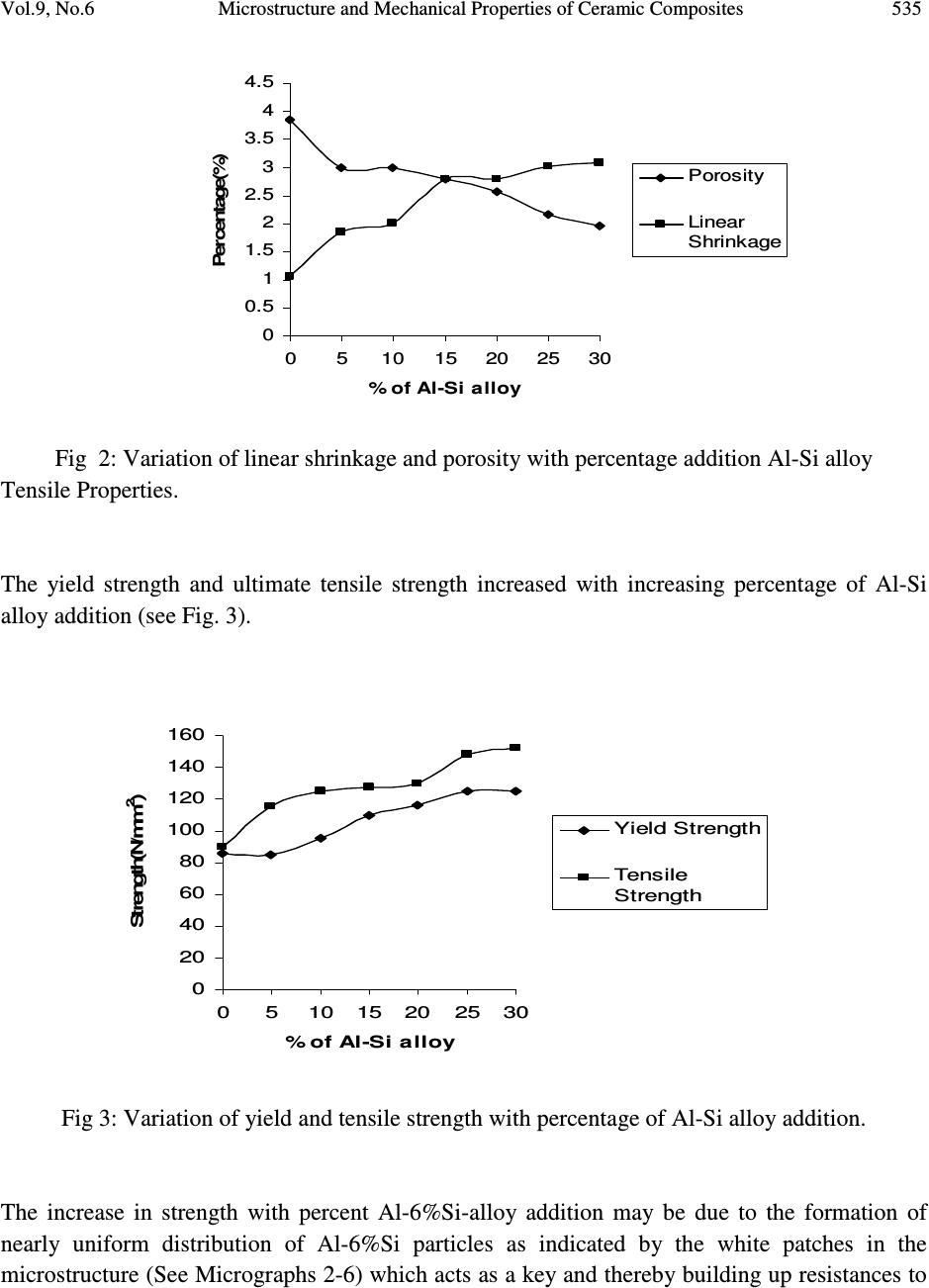 Vol.9, No.6 Microstructure and Mechanical Properties of Ceramic Composites 535 Fig 2: Variation of linear shrinkage and porosity with percentage addition Al-Si alloy Tensile Properties. The yield strength and ultimate tensile strength increased with increasing percentage of Al-Si alloy addition (see Fig. 3). Fig 3: Variation of yield and tensile strength with percentage of Al-Si alloy addition. The increase in strength with percent Al-6%Si-alloy addition may be due to the formation of nearly uniform distribution of Al-6%Si particles as indicated by the white patches in the microstructure (See Micrographs 2-6) which acts as a key and thereby building up resistances to 0 0.5 1 1.5 2 2.5 3 3.5 4 4.5 051015 20 25 30 % of Al-Si alloy Percentage(%) Porosity Linear Shrinkage 0 20 40 60 80 100 120 140 160 0510 15 2025 30 % of Al-Si alloy Strength(N/mm 2 ) Yield Strength Tensile Strength  536 V.S. Aigbodion, J.O. Agunsoye, V. Kalu, F. Asuke, S. Ola Vol.9, No.6 slip, hence increasing the strength of the reinforced ceramic phase (tin tailings) and the composite in general [7]. The addition of Al-6%Si alloy particles to the tin tailings ceramic matrix increases the dislocation density at the particles-matrix interfaces. This is in agreement with the result obtained by [9]. This is because of the differences in coefficient of thermal expansion (CTE) between the hard and brittle ceramic matrix and the soft and ductile reinforcing particles of Al-6%Si alloy, elastic and plastic incompatibility between the matrix and reinforcement, which leads to interaction stress. Hence there is an improvement in the strength of tin tailings reinforced with Al-6%Si alloy particles [7-9]. 3.2.5 Hardness The hardness values decreased as the weight fraction of the Al-Si alloy increased (see Fig 4) because of the addition of the soft metal phase to the hard ceramic phase. Fig 4: Variation of hardness with percentage addition of Al-Si alloy. 3.2.6 Impact Property The impact energy gives an indication of how tough the composite would be and was found to increase as the weight fraction of the Al-6%Si alloy increased. Originally, the impact energy of the tin tailings (ceramic phase) was 5 joules, but as the percentage of the Al-6%Si alloy increased, the impact energy is improved due to the increase in the ductile metal phase (Al- 6%Si)(see Figure 5) which would give the composite enough plasticity to absorb energy. 0 20 40 60 80 100 120 140 160 051015 2025 30 % of Al-Si alloy Hardness values(HRB) 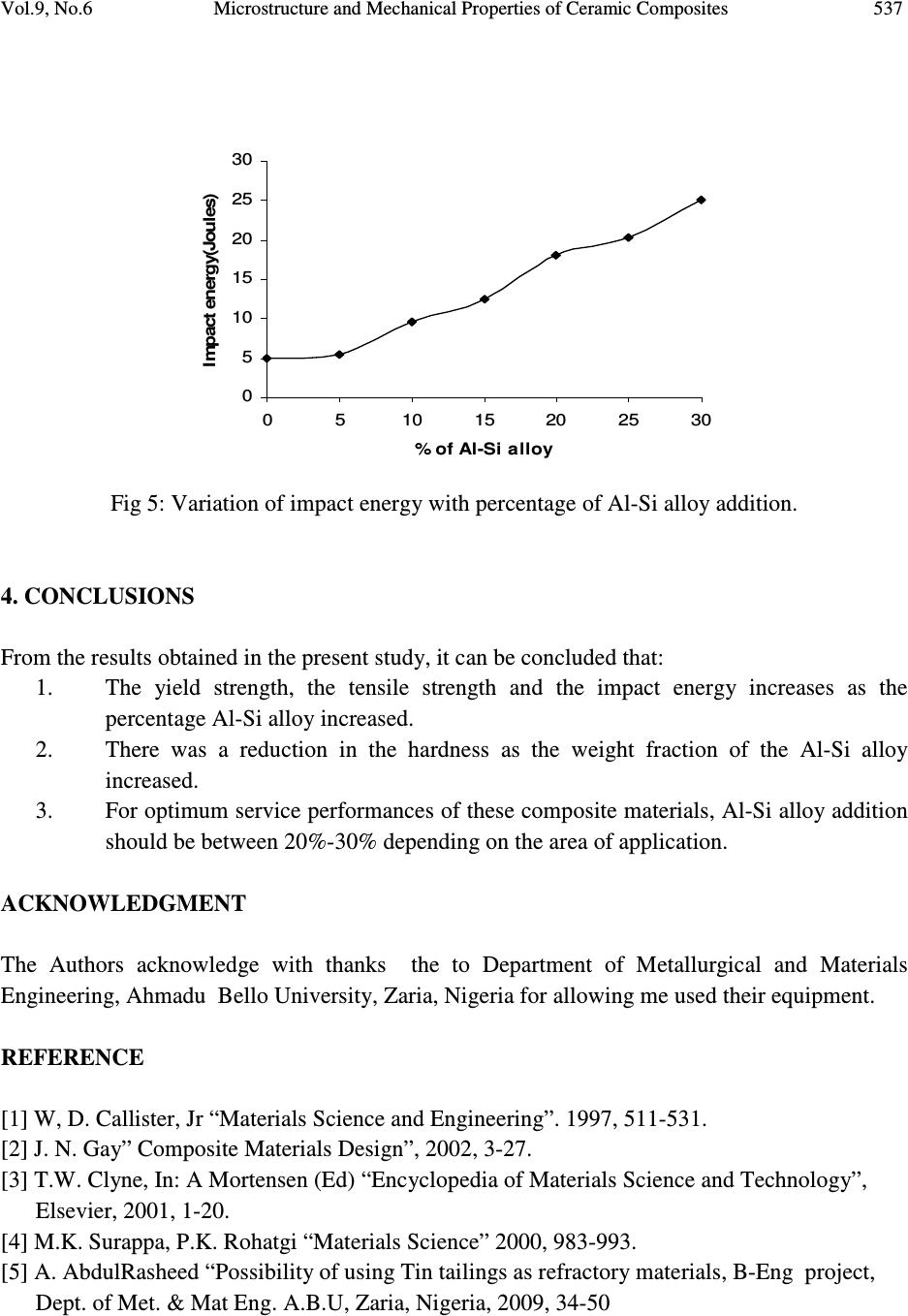 Vol.9, No.6 Microstructure and Mechanical Properties of Ceramic Composites 537 0 5 10 15 20 25 30 0510 1520 25 30 % of Al-Si alloy Impact energy(Joules) Fig 5: Variation of impact energy with percentage of Al-Si alloy addition. 4. CONCLUSIONS From the results obtained in the present study, it can be concluded that: 1. The yield strength, the tensile strength and the impact energy increases as the percentage Al-Si alloy increased. 2. There was a reduction in the hardness as the weight fraction of the Al-Si alloy increased. 3. For optimum service performances of these composite materials, Al-Si alloy addition should be between 20%-30% depending on the area of application. ACKNOWLEDGMENT The Authors acknowledge with thanks the to Department of Metallurgical and Materials Engineering, Ahmadu Bello University, Zaria, Nigeria for allowing me used their equipment. REFERENCE [1] W, D. Callister, Jr “Materials Science and Engineering”. 1997, 511-531. [2] J. N. Gay” Composite Materials Design”, 2002, 3-27. [3] T.W. Clyne, In: A Mortensen (Ed) “Encyclopedia of Materials Science and Technology”, Elsevier, 2001, 1-20. [4] M.K. Surappa, P.K. Rohatgi “Materials Science” 2000, 983-993. [5] A. AbdulRasheed “Possibility of using Tin tailings as refractory materials, B-Eng project, Dept. of Met. & Mat Eng. A.B.U, Zaria, Nigeria, 2009, 34-50 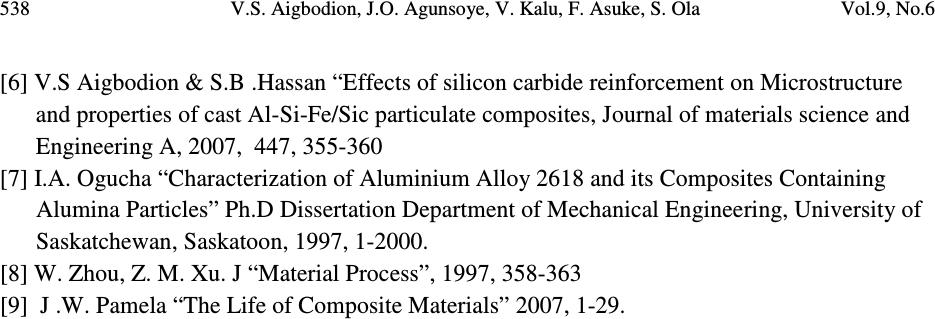 538 V.S. Aigbodion, J.O. Agunsoye, V. Kalu, F. Asuke, S. Ola Vol.9, No.6 [6] V.S Aigbodion & S.B .Hassan “Effects of silicon carbide reinforcement on Microstructure and properties of cast Al-Si-Fe/Sic particulate composites, Journal of materials science and Engineering A, 2007, 447, 355-360 [7] I.A. Ogucha “Characterization of Aluminium Alloy 2618 and its Composites Containing Alumina Particles” Ph.D Dissertation Department of Mechanical Engineering, University of Saskatchewan, Saskatoon, 1997, 1-2000. [8] W. Zhou, Z. M. Xu. J “Material Process”, 1997, 358-363 [9] J .W. Pamela “The Life of Composite Materials” 2007, 1-29. |

